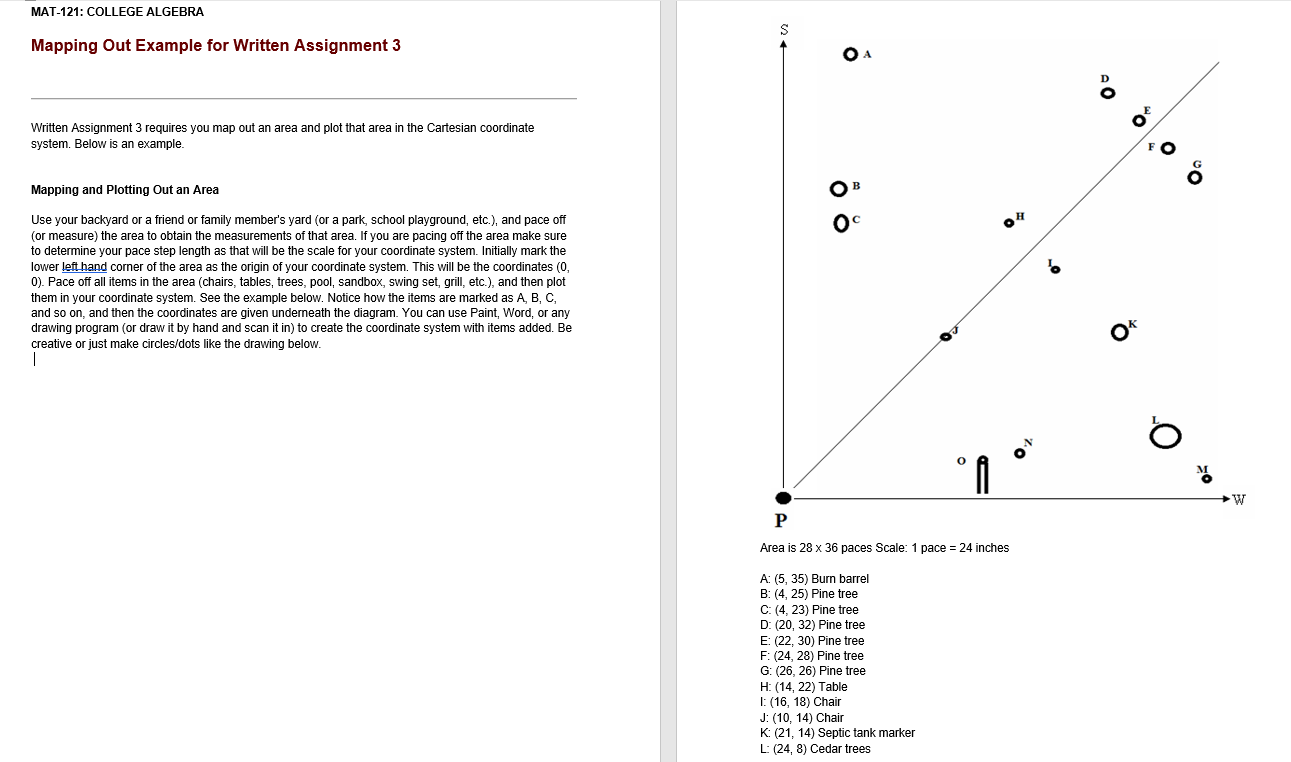Use your backyard or a friend or family member's yard (or a park, school playground, etc.), and pace off (or measure) the area to obtain the measurements of that area. If you are pacing off the area make sure to determine your pace step length as that will be the scale for your coordinate system. Initially mark the lower left hand corner of the area as the origin of your coordinate system. This will be the coordinates (0, 0). Pace off all items in the area (chairs, tables, trees, pool, sandbox, swing set, grill, etc.), and then plot them in your coordinate system. See the example below. Notice how the items are marked as A, B, C, and so on, and then the coordinates are given underneath the diagram. You can use Paint, Word, or any drawing program (or draw it by hand and scan it in) to create the coordinate system with items added. Be creative or just make circles/dots like the drawing below.
Area is 28 x 36 paces Scale: 1 pace = 24 inches
A: (5, 35) Burn barrel
B: (4, 25) Pine tree
C: (4, 23) Pine tree
D: (20, 32) Pine tree
E: (22, 30) Pine tree
F: (24, 28) Pine tree
G: (26, 26) Pine tree
H: (14, 22) Table
I: (16, 18) Chair
J: (10, 14) Chair
K: (21, 14) Septic tank marker
L: (24, 8) Cedar trees
M: (26, 2) Grey water drain pipe
N: (15, 3) Ground water drain pipe
O: (12, 3) Gutter downspout
P: Origin (0, 0)
Midpoint:
Distance from origin to upper right corner of the coordinate system: paces. Give a simplified radical version and a decimal version to the nearest tenth of a pace.
Now translate your coordinate system so that the midpoint is the origin of your area. Give the new coordinates of the items in your area. For example, since my midpoint's coordinates were (14, 18), everything will be translated by those values. Take the x coordinate of the item and subtract the x coordinate of the midpoint. Do the same for the y coordinate. Point A above originally had coordinates (5, 35). Subtracting 14 from 5 gives -9 and subtracting 18 from 35 gives 17. The new coordinates for A are (-9, 17)


MAT-121: COLLEGE ALGEBRA Mapping Out Example for Written Assignment 3 OA oo Written Assignment 3 requires you map out an area and plot that area in the Cartesian coordinate system. Below is an example. Mapping and Plotting Out an Area % OC Use your backyard or a friend or family member's yard (or a park, school playground, etc.), and pace off (or measure) the area to obtain the measurements of that area. If you are pacing off the area make sure to determine your pace step length as that will be the scale for your coordinate system. Initially mark the lower left hand corner of the area as the origin of your coordinate system. This will be the coordinates (0, 0). Pace off all items in the area (chairs, tables, trees, pool, sandbox, swing set, grill, etc.), and then plot them in your coordinate system. See the example below. Notice how the items are marked as A, B, C, and so on, and then the coordinates are given underneath the diagram. You can use Paint, Word, or any drawing program (or draw it by hand and scan it in) to create the coordinate system with items added. Be creative or just make circles/dots like the drawing below. 1 no M Area is 28 x 36 paces Scale: 1 pace = 24 inches A: (5, 35) Burn barrel B: (4, 25) Pine tree C: (4, 23) Pine tree D: (20,32) Pine tree E: (22, 30) Pine tree F: (24, 28) Pine tree G: (26, 26) Pine tree H: (14, 22) Table I: (16,18) Chair J: (10, 14) Chair K: (21, 14) Septic tank marker L: (24, 8) Cedar trees M: (26, 2) Grey water drain pipe N: (15, 3) Ground water drain pipe O: (12, 3) Gutter downspout P: Origin (0,0) OA 18 +0 36 +0 2 }=(14,18) Midpoint: Distance from origin to upper right corner of the coordinate system: VI28-0 28-01 +{36-01* = 47150 x 45.6 OB paces. Give a simplified radical version and a decimal version to the nearest tenth of a pace. Now translate your coordinate system so that the midpoint is the origin of your area. Give the new coordinates of the items in your area. For example, since my midpoint's coordinates were (14, 18), everything will be translated by those values. Take the x coordinate of the item and subtract the x coordinate of the midpoint. Do the same for the y coordinate. Point A above originally had coordinates (5, 35). Subtracting 14 from 5 gives -9 and subtracting 18 from 35 gives 17. The new coordinates for A are (- 9, 17) New Coordinates after Translation to Midpoint as Origin A: (-9, 17) B:(-10,7) C: (-10,5) D: (6, 14) E: (8, 12) F: (10,10) G: (12,8) H: (0,4) 1: (2,0) J: (-4,-4) K: (7,-4) L: (10,-10) A M: (12.-16) L: (1, -15) M: (12,-16) N: (1, -15) P O: (-2, -15) P: (-14, -18) Here is the new coordinate system with the axes translated to the midpoint MAT-121: COLLEGE ALGEBRA Mapping Out Example for Written Assignment 3 OA oo Written Assignment 3 requires you map out an area and plot that area in the Cartesian coordinate system. Below is an example. Mapping and Plotting Out an Area % OC Use your backyard or a friend or family member's yard (or a park, school playground, etc.), and pace off (or measure) the area to obtain the measurements of that area. If you are pacing off the area make sure to determine your pace step length as that will be the scale for your coordinate system. Initially mark the lower left hand corner of the area as the origin of your coordinate system. This will be the coordinates (0, 0). Pace off all items in the area (chairs, tables, trees, pool, sandbox, swing set, grill, etc.), and then plot them in your coordinate system. See the example below. Notice how the items are marked as A, B, C, and so on, and then the coordinates are given underneath the diagram. You can use Paint, Word, or any drawing program (or draw it by hand and scan it in) to create the coordinate system with items added. Be creative or just make circles/dots like the drawing below. 1 no M Area is 28 x 36 paces Scale: 1 pace = 24 inches A: (5, 35) Burn barrel B: (4, 25) Pine tree C: (4, 23) Pine tree D: (20,32) Pine tree E: (22, 30) Pine tree F: (24, 28) Pine tree G: (26, 26) Pine tree H: (14, 22) Table I: (16,18) Chair J: (10, 14) Chair K: (21, 14) Septic tank marker L: (24, 8) Cedar trees M: (26, 2) Grey water drain pipe N: (15, 3) Ground water drain pipe O: (12, 3) Gutter downspout P: Origin (0,0) OA 18 +0 36 +0 2 }=(14,18) Midpoint: Distance from origin to upper right corner of the coordinate system: VI28-0 28-01 +{36-01* = 47150 x 45.6 OB paces. Give a simplified radical version and a decimal version to the nearest tenth of a pace. Now translate your coordinate system so that the midpoint is the origin of your area. Give the new coordinates of the items in your area. For example, since my midpoint's coordinates were (14, 18), everything will be translated by those values. Take the x coordinate of the item and subtract the x coordinate of the midpoint. Do the same for the y coordinate. Point A above originally had coordinates (5, 35). Subtracting 14 from 5 gives -9 and subtracting 18 from 35 gives 17. The new coordinates for A are (- 9, 17) New Coordinates after Translation to Midpoint as Origin A: (-9, 17) B:(-10,7) C: (-10,5) D: (6, 14) E: (8, 12) F: (10,10) G: (12,8) H: (0,4) 1: (2,0) J: (-4,-4) K: (7,-4) L: (10,-10) A M: (12.-16) L: (1, -15) M: (12,-16) N: (1, -15) P O: (-2, -15) P: (-14, -18) Here is the new coordinate system with the axes translated to the midpoint








